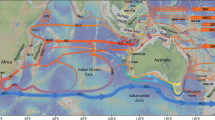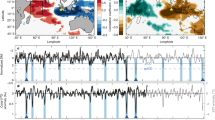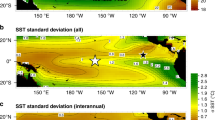Abstract
The interplay of the El Niño Southern Oscillation, Asian monsoon and Indian Ocean Dipole (IOD)1,2,3 drives climatic extremes in and around the Indian Ocean. Historical4,5 and proxy6,7,8,9 records reveal changes in the behaviour of the El Niño Southern Oscillation and the Asian monsoon over recent decades10,11,12. However, reliable instrumental records of the IOD cover only the past 50 years1,3, and there is no consensus on long-term variability of the IOD or its possible response to greenhouse gas forcing13. Here we use a suite of coral oxygen-isotope records to reconstruct a basin-wide index of IOD behaviour since AD 1846. Our record reveals an increase in the frequency and strength of IOD events during the twentieth century, which is associated with enhanced seasonal upwelling in the eastern Indian Ocean. Although the El Niño Southern Oscillation has historically influenced the variability of both the IOD and the Asian monsoon3,8,10, we find that the recent intensification of the IOD coincides with the development of direct, positive IOD–monsoon feedbacks. We suggest that projected greenhouse warming may lead to a redistribution of rainfall across the Indian Ocean and a growing interdependence between the IOD and Asian monsoon precipitation variability.
This is a preview of subscription content, access via your institution
Access options
Subscribe to this journal
Receive 12 print issues and online access
$259.00 per year
only $21.58 per issue
Buy this article
- Purchase on Springer Link
- Instant access to full article PDF
Prices may be subject to local taxes which are calculated during checkout



Similar content being viewed by others
References
Saji, N. H., Goswami, B. N., Vinayachandran, P. H. & Yamagata, T. A dipole mode in the tropical Indian Ocean. Nature 401, 360–363 (1999).
Webster, P. J., Moore, M. D., Loschnigg, J. P. & Leben, R. R. Coupled ocean–atmosphere dynamics in the Indian Ocean during 1997–98. Nature 401, 356–360 (1999).
Saji, N. H. & Yamagata, T. Structure of SST and surface wind variability during Indian Ocean Dipole Mode events: COADS observations. J. Clim. 2735–2751 (2003).
Parthasarathy, B., Munot, A. A. & Kothawale, D. R. Contributions from Indian Institute of Tropical Meteorology, Research Report RR-065, Aug 1995, Pune 411 008, India (1995).
Kaplan, A. et al. Analysis of global sea surface temperature 1856–1991. J. Geophys. Res. 103, 18567–18589 (1998).
Charles, C. D., Hunter, D. E. & Fairbanks, R. G. Interaction between the ENSO and the Asian monsoon in a coral record of tropical climate. Science 277, 925–928 (1997).
Urban, F. E., Cole, J. E. & Overpeck, J. T. Influence of mean climate change on climate variability from a 155-year tropical Pacific coral record. Nature 407, 989–993 (2000).
Charles, C. D., Cobb, K. M., Moore, M. D. & Fairbanks, R. G. Monsoon–tropical ocean interaction in a network of coral records spanning the 20th century. Mar. Geol. 201, 207–222 (2003).
Pfeiffer, M. & Dullo, W.-C. Monsoon-induced cooling of the western equatorial Indian Ocean as recorded in coral oxygen isotope records from the Seychelles covering the period of 1840–1994 AD. Quat. Sci. Rev. 25, 993–1009 (2006).
Kumar, K. K., Rajagopalan, B. & Cane, M. A. On the weakening relationship between the Indian Monsoon and ENSO. Science 284, 2156–2159 (1999).
Vecchi, G. A. et al. Weakening of tropical Pacific atmospheric circulation due to anthropogenic forcing. Nature 441, 73–76 (2006).
Goswami, B. N., Venugopal, V., Sengupta, D., Madhusoodanan, M. S. & Xavier, P. K. Increasing trend of extreme rain events over India in a warming environment. Science 314, 1442–1445 (2006).
Conway, D., Hanson, C. E., Doherty, R. & Persechino, A. GCM simulations of the Indian Ocean dipole influence on East African rainfall: Present and future. Geophys. Res. Lett. 34, L03705 (2007).
Ashok, K., Guan, Z. & Yamagata, T. Influence of the Indian Ocean Dipole on the Australian winter rainfall. Geophys. Res. Lett. 30, 1821 (2003).
Abram, N. J., Gagan, M. K., McCulloch, M. T., Chappell, J. & Hantoro, W. S. Coral reef death during the 1997 Indian Ocean Dipole linked to Indonesian wildfires. Science 301, 952–955 (2003).
Meyers, G., McIntosh, P., Pigot, L. & Pook, M. The years of El Niño, La Niña and interactions with the tropical Indian Ocean. J. Clim. 20, 2872–2880 (2007).
Ashok, K., Guan, Z., Saji, N. H. & Yamagata, T. Individual and combined influences of ENSO and the Indian Ocean Dipole on the Indian summer monsoon. J. Clim. 17, 3141–3155 (2004).
Gadgil, S., Vinayachandran, P. H., Francis, P. A. & Gadgil, S. Extremes of the Indian summer monsoon rainfall, ENSO and equatorial Indian Ocean oscillation. Geophys. Res. Lett. 31, L12213 (2004).
Swapna, P. & Krishnan, R. Equatorial undercurrents associated with Indian Ocean Dipole events during contrasting summer monsoons. Geophys. Res. Lett. 35, L14S04 (2008).
Abram, N. J. et al. Seasonal characteristics of the Indian Ocean Dipole during the Holocene epoch. Nature 445, 299–302 (2007).
Reynolds, R. W., Rayner, N. A., Smith, T. M., Stokes, D. C. & Wang, W. An improved in situ and satellite SST analysis for climate. J. Clim. 15, 1609–1625 (2002).
Fischer, A. S., Terray, P., Guilyardi, E., Gualdi, S. & Delecluse, P. Two independent triggers for the Indian Ocean Dipole/Zonal Mode in a coupled GCM. J. Clim. 18, 3428–3449 (2005).
Mudelsee, M., Börngen, M., Tetzlaff, G. & Grünewald, U. No upward trends in the occurrence of extreme floods in central Europe. Nature 425, 166–169 (2003).
Luo, J. J., Behera, S. K., Masumoto, Y., Sakuma, H. & Yamagata, T. Successful prediction of the consecutive IOD in 2006 and 2007. Geophys. Res. Lett. 35, L14S02 (2008).
Alory, G., Wijffels, S. E. & Meyers, G. Observed temperature trends in the Indian Ocean over 1960–1999 and associated mechanisms. Geophys. Res. Lett. 34, L02606 (2007).
Bakun, A. Global climate change and intensification of coastal ocean upwelling. Science 247, 198–201 (1990).
McGregor, H. V., Dima, M., Fischer, H. W. & Mulitza, Rapid 20th-century increase in coastal upwelling off northwest Africa. Science 315, 637–639 (2007).
Meehl, G. A. et al. in Climate Change 2007: The Physical Science Basis. Contribution of Working Group 1 to the Fourth Assessment Report of the Intergovernmental Panel on Climate Change (eds Solomon, S. et al.) 747–845 (Cambridge Univ. Press, 2007).
Xie, P. & Arkin, P. A. Analyses of global monthly precipitation using gauge observations, satellite estimates, and numerical model predictions. J. Clim. 9, 840–858 (1996).
Woodruff, S. D., Diaz, H. F., Worley, S. J., Reynolds, R. W. & Lubker, S. J. Early ship observational data and ICOADS. Clim. Change 73, 169–194 (2005).
Acknowledgements
We thank B. Suwargadi, D. Prayudi, I. Suprianto, K. Glenn, T. Watanabe, H. Scott-Gagan, K. Sieh and the Indonesian Institute of Sciences (LIPI) for logistical support and technical assistance with fieldwork, which was carried out under LIPI Research Permit numbers 3551/I/KS/1999 and 2889/II/KS/2001. We also thank H. Scott-Gagan and J. Cali for laboratory assistance. C. Charles and M. Pfeiffer are thanked for providing published coral data. This study was supported by an Australian Postgraduate Award and RSES Jaeger Scholarship to N.J.A., and an Australian Research Council grant (DP0663227) to M.K.G. and W.S.H.
Author information
Authors and Affiliations
Contributions
N.J.A. was responsible for coral geochemical analysis and interpretation of the records. M.K.G. was Chief Investigator and the Australian Institutional Counterpart for the ARC project. J.E.C. provided the spectral analysis. W.S.H. was Partner Investigator and the Indonesian Institutional Counterpart for the ARC project. M.M. assisted in statistical analysis. N.J.A., M.K.G. and J.E.C. wrote the paper.
Corresponding authors
Supplementary information
Supplementary Information, Fig. S1
Supplementary Information (PDF 1185 kb)
Rights and permissions
About this article
Cite this article
Abram, N., Gagan, M., Cole, J. et al. Recent intensification of tropical climate variability in the Indian Ocean. Nature Geosci 1, 849–853 (2008). https://doi.org/10.1038/ngeo357
Received:
Accepted:
Published:
Issue Date:
DOI: https://doi.org/10.1038/ngeo357
This article is cited by
-
Future Indian Ocean warming patterns
Nature Communications (2023)
-
Consolidating historical instrumental observations in southern Australia for assessing pre-industrial weather and climate variability
Climate Dynamics (2023)
-
Relationship between coral bleaching and large-scale oscillations in the Lakshadweep archipelago
Ocean Dynamics (2023)
-
Coral Sr/Ca records provide realistic representation of eastern Indian Ocean cooling during extreme positive Indian Ocean Dipole events
Scientific Reports (2022)
-
Local meridional circulation changes contribute to a projected slowdown of the Indian Ocean Walker circulation
npj Climate and Atmospheric Science (2022)



